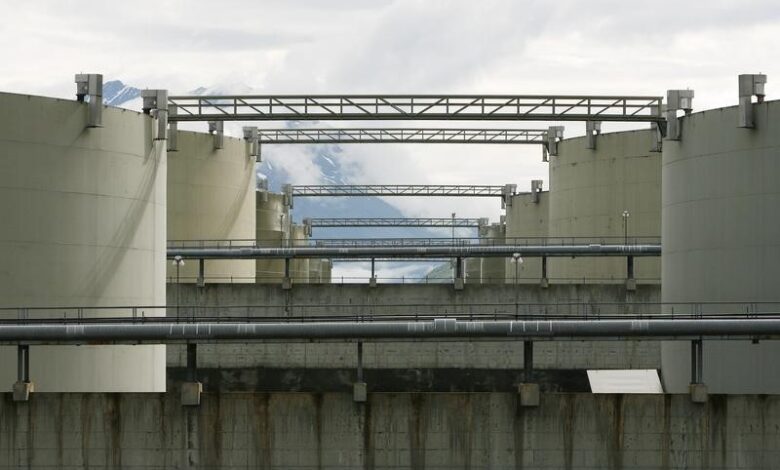Energy & precious metals – weekly review and outlook By Investing.com

[ad_1]
By Barani Krishnan
Investing.com — So, how low could go in the coming week?
Let’s not kid ourselves that it isn’t what every crude trader wants to know, though those who are long will also be wondering if there will be a rebound adequate and soon enough to make up for what happened in the just-ended week.
I think it’s safe to say that a 13% loss on the week — the worst since the pandemic — wasn’t anywhere in the wildest fantasies of oil bears. But now that they’ve got it, those shorting the market would be wondering how much lower they can drive it.
If my regular collaborator on technical charts, Sunil Kumar Dixit, is right — and I’ve no reason to doubt him — U.S. crude’s , which settled on Friday at $66.74 per barrel, after a 15-month low at $65.27 — could go below $60 in the near-term.
“If we buck the $62 level and selling intensifies, expect a drop to the major support at the 100-Month SMA of $58.90,” Dixit said, referring to the Simple Moving Average marker for WTI.
But Dixit also thinks crude prices might rebound, even return to their most recent $70 perch, before going any lower than $58.
“There’s a strong possibility of a technical spring from the current lows,” he said. “If it doesn’t happen right away, it could upon reaching the support areas of $62 and $58.90. We have initial rebound targets at $69.20 and $71.50. We believe a technical rebound will start either from current lows of $65, as WTI has already tested the 200-week SMA of $66.18.”
There’s something else happening this week that has major ramifications not just for oil but all markets and cannot be ignored: the Federal Reserve on Wednesday.
The Fed is to go for another 25-basis point hike at its March 22 meeting. Wall Street, of course, wants the central bank to stop all rate hikes so that the can be driven up another 500 points. The Fed is being cautioned that more monetary tightening could lead to another financial crisis like in 2008. That warning is emotional blackmail in another name as the central bank is being told that the banking crisis is entirely the fault of its , not reckless risk-taking by the executives of the financial firms that went under.
The banking crisis is also pitted against what is described as a genuine supply-demand crisis in oil. Day in and out, we hear the refrain of oil bulls on how precariously tight supply is.
“While demand is going up, we’re seeing global production fall,” Phil Flynn, analyst at Chicago’s Price Futures Group and one of the loudest voices on the long side of oil, said in his daily note on Friday.
“U.S. production is at risk as [drilling] rig counts have been falling in recent weeks,” said Flynn. He cites surging Chinese oil demand that is pushing up shipping costs, U.S. crude exports at 2 1/2 year highs and three-month highs in Saudi oil shipments in January.
“The recent plunge in price is not installing confidence to invest a lot of money to bring more production on right now,” Flynn laments.
What’s happening now is a crisis of confidence in the financial system, which, while may not be appreciated by all, is just as important as supply-demand.
For those who care, I did a deep dive on this in an over the weekend, but here’s the skinny version for you, otherwise:
The global oil trade might be worth close to $200 billion at current pricing but not a barrel of crude might move without the funding, or liquidity, provided by banks. Banks are the market makers for all commodities, not just oil, as they bring together buyers and sellers that have different needs, risks, time horizons, and incentives.
The consequences of impairing the role played by banks in commodities could be far-reaching and negative. The development of new wind farms and natural gas power plants may be curtailed because of the inability of developers to hedge their price risks. Independent oil and gas producers and dealers would have limited ability to hedge the price risks associated with investment and inventory. Airlines, highly vulnerable to jet fuel prices, could be put at risk.
Refineries could be shut down, leading to higher gasoline prices. Overall, competition would be reduced in energy markets, and smaller players would be disadvantaged. Higher volatility would lead to foreshortening of domestic investment, leading to increased foreign energy dependence. And consumers—and the U.S. economy—would be hurt by higher and more uncertain prices.
If banks were to stay out of raw materials markets, it is not at all clear who could replace them or to what extent. Some markets would be more opaque, less-transparent entities based outside the United States. Others could be large competitors to the small- and medium-sized companies being served by the banks. All of them would be much less regulated than banks, which are among the most highly regulated entities in the United States.
There you have it — the critical liquidity and price discovery role played by banks and why the crisis of confidence in the sector now strikes at the very heart of the oil trade. Without the banks, the oil market — or, for that matter, any commodity market — might just not exist in the current structure that we’ve come to depend on for decades.
Gold: Market Settlements and Activity
Gold hit 11-month highs, breaking from the clutches of mid-$1,900 pricing to head for bullion bulls’ long-term target of $2,000, as the U.S. banking crisis drove more investors towards safe havens on Friday.
“The return of bank angst is sending gold prices sharply higher,” said Ed Moya, analyst at online trading platform OANDA. “Many gold investors are looking at the short-term macro risks and it seems that a wide range of expectations should mostly be positive for bullion.”
The on New York’s Comex did a final trade of $1,993.70 on Friday. It settled the official session at $1,973.50 an ounce, up $50.50, or 2.6%. The session high was the final trade of $1,993.70. Based on its official settlement, April gold ended the week up $106.30, or 5.7%.
The , more closely followed than futures by some traders, settled at $1,989.34, up $69.79, or 3.6% on the day. The session high for bullion was $1,989.39, also marking an 11-month high. For the week, spot gold rose by a whopping $122.34, or 6.6%.
Gold prices have been on a tear since the U.S. banking crisis erupted a week ago with the takeover of two mid-sized lenders — Silicon Valley Bank and Signature Bank — by the Federal Deposit Insurance Corp as depositors yanked billions of dollars from them over fears about their solvency. Silicon Valley filed for bankruptcy protection over the past 24 hours. A third bank, First Republic (NYSE:), is also in trouble despite receiving a $30 billion cash infusion from a consortium of banks.
Elsewhere, the banking crisis has spread to Europe, with Credit Suisse (NYSE:), one of the preeminent names in global investment banking, having to seek help from Switzerland’s central bank.
Persistent interest rate hikes by the Fed have also led to fears that the U.S. economy could end up in a deep recession.
Whichever way the central bank goes now could be a boon for gold, said Ed Moya, analyst at online trading platform OANDA.
“If the Fed is done with rate hikes, that should be bullish for gold as it puts a short-term cap on the dollar,” Moya said. “If inflation proves to be stickier and the Fed has to resume tightening, that would deliver a major blow to the economy and trigger many safe-haven flows for gold.”
Moya said gold could hover at around $1,950 leading up to Wednesday’s rate decision, adding that Wall Street might have a better handle after that on how bad a recession the U.S. may be facing. “Safe-haven flows into gold should be steady as the economy enters a recession,” he added.
Gold: Price Outlook
As spot gold’s 4-Hour Relative Strength Index reaches overbought conditions at 82, some pullback towards the support corridor of $1,965-$1,955 is a high probability, said Dixit of SKCharting.
“This is likely before we embark on a further advance towards $1,998, a conservative initial target which is a doorway to the bigger target of $2,068-$2,073,” said Dixit.
If momentum weakened below $1,965-$1,955, gold is likely to witness further correction towards the major support zones of $1932-$1928, Dixit added.
“Overall, the broader perspective favors a retest of the record high of $2073, or at least $2068,” he said.
“We are going to witness either a strong correction from near $2,068-$2,073 or a new high is going to be established if gold gathers enough velocity above $,2073.”
Natural gas: Market Settlements and Activity
The on the New York Mercantile Exchange’s Henry Hub did a final trade at $2.350 per mmBtu, or million metric British thermal units, on Friday. It settled the official session at $2.338 — down 17.6 cents, or 7%.
A mostly warm 2022/23 winter has led to considerably less heating demand in the United States versus the norm, leaving more gas in storage than initially thought.
Responding to the warmth and lackluster storage draws, gas prices plunged from a 14-year high of $10 per mmBtu in August, reaching $7 in December before trading mostly at mid-$2 levels over the past month.
stood at a total 1.972 tcf, or trillion cubic feet, as of March 10 — up 36% from the year-ago level of 1.451 tcf and 24% higher than the five-year average of 1.594 tcf, the EIA, or Energy Information Administration, reported.
That balance was after another unimpressive weekly drawdown of just 58 bcf, or billion cubic feet, from storage versus forecasts for a 62 bcf deficit and the previous week’s drop of 84 bcf.
Analysts doubted that weekly draws of gas in the near term will make a measurable dent in storage to push prices up.
“With around 3 weeks left in the withdrawal season and current inventories of 1.97 tcf, the remaining withdrawals will have to average around 60 bcf, much higher than expectations,” analysts at Houston-based energy markets consultancy Gelber & Associates said in a note.
Weather forecasts as of Friday morning were calling for heavy snow across portions of the central plains and upper U.S. Midwest, Gelber said, adding that a winter storm was likely to linger through Friday and Saturday but not expected to cause disruptions to natural gas production.
“Currently, it seems that the market may have a hard time getting down to 1.8 tcf carry out, even with some cold,” the Gelber note added.
Natural gas: Price Outlook
Negating the recovery signs that tried to pop up when gas bounced from $1.97 to $3.02, bulls in the market were far off from the point of calling it a day for the bears, said Dixit of SKCharting.
“At this point, either gas drops a little more to retest $2.15, like doing a swing low to $1.96 to start a technical rebound, or runs the risk of a correction digging deeper into $1.76 and $1.50,” he said. “This is my thesis before any signs of exhaustion in the bearish trend appear.”
On the positive side, if gas gets back to $3.04, the first challenge to the upside will be $3.30 and $3.75, Dixit added.
Disclaimer: Barani Krishnan does not hold positions in the commodities and securities he writes about.
[ad_2]
Source link



